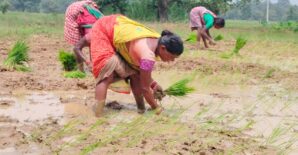Almost a year after the February 2022 Russian invasion in Ukraine, fears of a period of sustained high global food prices have subsided somewhat, but eight major concerns for food security remain.
First, prices for food commodities remain high by historical standards. As shown in Figure 1, the UN Food and Agriculture Organization (FAO) index for internationally traded food commodities, after rising during the initial months of the war, is now back to its pre-war, end of 2021 level—but still remains well above levels of preceding years. This holds for all main components of the index (cereals, meat, dairy, vegetable oils, and sugar). Vegetable oil prices showed the strongest decline in the second half of 2022, falling by 33% between June and December, but still are one third above pre-COVID levels.
Figure 1
Second, markets for staple foods remain tight. Global stock-to-use ratios for grains remain at around or below the lows of recent years (Figure 2). This indicates price instability is likely to intensify with any major supply shock, especially when also considering the ongoing uncertainty around the actual availability and exportability of grains stored in Ukraine as the war continues.
Third, after disrupting exports of Ukraine’s 2021 and 2022 crops, the war now threatens Ukraine’s 2023 commodity supplies. Fall plantings of wheat were down by as much as 40% from 2022 levels, and the conflict will likely have a significant negative impact on spring plantings.
Figure 2
Fourth, fertilizer prices have fallen from their peaks but also remain high, despite recent drops in natural gas prices (a major input for nitrogenous fertilizer as well as an energy source for the production process) as shown in Figure 3. Constraints on supplies of potash, including the ban of exports from Belarus, are keeping upward pressure on prices. With output prices for staple foods falling, these high input costs are depressing farm profitability. This likely will depress fertilizer usage, which in turn will affect yields, especially of rice, wheat, and maize. A first concern is with rice; production dropped somewhat in 2022 and prospects of lower stocks have led to a surge in prices for rice in futures markets.
Figure 3
Fifth, adverse climatic conditions in the southern hemisphere have overlapped with prolonged drought conditions in Argentina and East Africa, resulting in sharply reduced 2023 production prospects for wheat and other crops compared to last year. Abnormally wet but favorable conditions in Australia and strong maize production in Brazil could compensate for some of this reduced cereal production (AMIS Market Monitor, December 2022).
These overall trends, together with high fertilizer prices, mean reduced prospects for global supplies of staple foods in 2023, even if—with no end to the war in sight—the recently extended Black Sea Grain Initiative remains in effect during the year.
Sixth, global demand for food may well weaken further during 2023, given the expected significant slowdown of the global economy. Without any more major disruptions, further global food shortages are not expected to emerge in 2023, though there could be shortages in local hotspots—such as in Afghanistan and the Horn of Africa—where conflict, new weather shocks and lack of import capacity may continue to affect food availability (see WFP-FAO hunger hotspot early warnings).
Seventh, the drop in world market prices of staple foods during the second half of 2022 has at best slowed domestic food price inflation very modestly in most countries. Consumer prices for both food and other essentials have continued to increase sharply in most parts of the world (Figure 4). As analyzed by Martin & Minot (2022), shifts in international prices have limited effects on domestic prices. For instance, on average less than half of the rise in global wheat prices was passed on to higher domestic wheat prices during the surges in 2021 and 2022. The pass-through is even lower when prices fall. When international wheat prices dropped by about 28% between May and July 2022, domestic prices for wheat products declined by only 8% on average. The low degree of transmission of global market prices of course relates to food import dependence, but to a large extent also to insulation policies, which can include export restrictions, lower import tariffs, and domestic food subsidies. While these policies have protected consumers from the impacts of the global food price shocks, they also contributed to the food price surges in the first half of 2022 (see Martin & Minot 2022).
Figure 4
Eighth, and most critically, low-income countries face ongoing macroeconomic problems that pose additional risks to food security. The capacity of governments to protect consumers from both international and domestic food price shocks is weakest in low-income countries, where the need for protection is greatest. Many people in such countries spend significant portions of their incomes on food, and as prices rise rely on forms of government support—yet after repeated shocks, public budgets are already over-extended. Efforts to mitigate the impacts of the COVID-19 pandemic on livelihoods have driven up government debt to unsustainable levels. The share of low-income countries in debt distress has doubled to 60% since 2015 (IMF 2022). Thus, high debt service obligations along with rising food and energy import prices have both constrained import capacity and weakened the currencies of these countries, which in turn has fanned domestic food price inflation.
Consequently, food affordability remains a challenge at both the macroeconomic level (capacity of countries to pay their food import bills) and at the household level (increased prices in local currency for imported food and energy, and reduced prospects to raise incomes given the outlook of a global economic slowdown). These risks will remain high going forward; without major debt relief and additional financial support from the international community, food prices are likely to continue to climb in 2023, posing a continuing threat to the food security of vulnerable households around the world.
Rob Vos is Director of IFPRI's Markets, Trade, and Institutions Division (MTID); Joseph Glauber and David Laborde are MTID Senior Research Fellows. Opinions are those of the authors.
This blog post is part of a special series on the global and regional food security implications of rising food and fertilizer prices that began with the pandemic and are now exacerbated by Russia’s invasion of Ukraine. The blog series is edited by IFPRI Senior Research Fellows Joseph Glauber and David Laborde to offer a range of perspectives and analyses on both the short- and long-term impacts. See the full series here.



